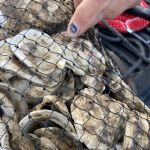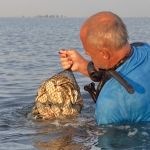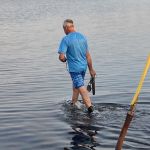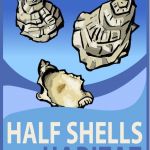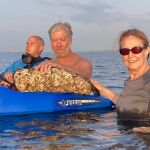Great South Bay Oyster Project
Photo Gallery
Recent Progress
Volunteer
Habitat Restoration

Habitat Restoration
We advocate for healing the creeks that feed our bay, for bay-friendly yards, for helping to return a shellfishing industry to the Great South Bay, and for the deployment of modern wastewater treatment technologies to address the problems caused by 500,000 cesspools and septic tanks, as well as the 197 large scale septic systems in malls, apartment complexes and locally.
Volunteer
Lend a hand! Join our Oyster Project Team and help revive The Great South Bay.
Partnering With Oyster Growers
Of course, nothing happens without cleaner water. That is why getting rid of our cesspools and septic tanks, healing our creeks, tackling runoff, and practicing natural lawn care is so important.
Please contact us with any suggestions you may have. You can also donate our efforts. We want to apply the latest techniques in aquaculture to revitalize our bay, our economy and our local culture.
We advocate for healing the creeks that feed our bay, for bay-friendly yards, for helping to return a shell fishing industry to the Great South Bay, and for the deployment of modern wastewater treatment technologies to address the problems caused by 500,000 cesspools and septic tanks, as well as the 197 large scale septic systems in malls, apartment complexes and locally.
Where You Can Get Fresh, Long Island Blue Point Oysters
- Neguntatogue Oysters (Lindenhurst) – call or text Keith & Nicole at 631-275-8046
- Blue Island Oysters (Sayville)- Call Chris at (631) 563-1330 for availability
- Maris Stella Oysters (Captree) – call or text Sixto at 516-939-5545
- Little A’s (Bay Shore) – call or text Michael at 917-526-1900
- Red Tiger (West Islip) – call or text Lou at 646-228-6273
The Making Of An Oyster Sanctuary
Site Evaluation
Establishing the Sanctuary
Enhancing and Measuring for Success
Recent Progress On Habitat Restoration
The New York State Department of Environmental Conservation (NYSDEC) Now Lacks the Budget and Man Power to Do Its Job — Is This a Bug or a Feature?
One preferred tactic for addressing laws you don’t like is to cut off funding to the point where those laws are no longer enforceable. Budgets are statements of priorities. The past ten years have seen sharp budget cuts at the NYSDEC — The New York State Department of Environmental Conservation. As a result, according to a report recently issued by The Environmental Advocates for New York, “The DEC is looking less, and finding less.”
Newsday Posts An Interactive Map And Database of Active and Closed Superfund Sites In Nassau and Suffolk County — All 254 Of Them
Newsday, which is now taking the whole issue of water quality quite seriously — Note the 5 part series that News12 airing Sept 23-27th: What’s In The Water? — has also posted an interactive map/listing of the 254 Superfund sites in Nassau and Suffolk. This useful tool for locating and learning the status of the 254 sites, unfortunately, may require a user subscription to view for non optonline/cablevision/newsday customers.
Some Interesting Titles About Water Quality from Earthprint.com
Here is a link for some books that might be of tremendous interest to the Save the Great South Bay community http://www.earthprint.com/emails/New-Recent-Water2013.php
9-10-13: The Long Island Clean Water Partnership Launch Covered by the Wall Street Journal
Long Island environmental groups are banding together to stem the flow of nitrogen into the region’s groundwater and bays.
The initiative announced Tuesday follows what environmentalists are calling the worst year on record for ecological problems related to nitrogen, a nutrient that feeds algal blooms blamed for devastating much of the island’s marine life over the last three decades.
10-7-13 Save The Date: Toxic Tides, Pesticides and Sewage Oh My! A Water Worries Community Forum From The Citizens Campaign For The Environment
Scientists have determined that increasing pollution from sewage, pesticides, and toxic chemicals threatens Long Island’s water. Aging sewer and septic systems leak nitrogen into our underground supply of fresh drinking water, which flows into our creeks, bays, and harbors. This leads to “red tides” and other environmental problems that choke sea life, kill fish, and poison shellfish that people eat.
Fortunately, we can fix it. Citizens Campaign for the Environment, Group for the East End, Long Island Pine Barrens Society, and The Nature Conservancy have been working together for over a year to form the Long Island Clean Water Partnership—a grassroots initiative to restore and protect Long Island’s water resources on a comprehensive level. But action by local, county, and state officials is needed right now if Long Island’s water quality is to be protected and restored for our children and grandchildren. We all have good reason to make sure our water supply is clean and healthy, and we each have a part to play in protecting it for the future.
A BREAK IN THE UNUSUAL MORTALITY EVENT OF BOTTLE NOSE DOLPHINS ON THE EAST COAST
The National Oceanic and Atmospheric Administration (NOAA) has determined that the 500 dolphin strandings and more than 330 dolphin deaths from New York to North Carolina this summer are likely due to a strain of morbillivirus which is the same family of viruses that causes measles in humans or canine distemper in dogs.

